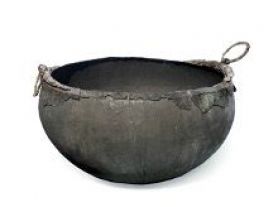Princely grave at Hatten

This Celtic funerary complex of the "princely" variety was uncovered in the centre of a 4 metre high mound, in an excavation carried out in the Seltz-Hatten forest in June 1851. It includes a bronze tableware service for the funeral banquet.
Among the metal vases imported from Etruscan cultures, there are two oenochoe or bronze jugs, their handles finely decorated with a feline head and palmettes.
A large, poorly preserved bronze cauldron, 50 centimetres in diameter, was used to mix wine and water.
The flat bronze bowl with horizontal handles that accompanies it gave the name "Hatten-type bowl" to all such vessels.
Traces of four iron wheel rings attest to the existence of a funerary chariot. The four bronze moulded buttons may have been part of its decoration.
The richness of this burial can also be seen from a thin gold band, perhaps belonging to a headdress.
The Etruscan origin of the tableware was confirmed by the archaeologists who studied the complex, dateing the whole grave to around 500 BC. The rich furniture, with its chariot, gold ornament and bronze tableware, make the Hatten tomb the most characteristic of princely-type burials excavated in Alsace.
